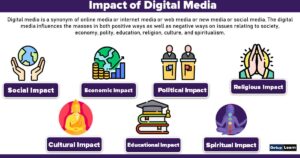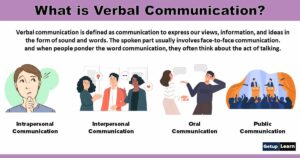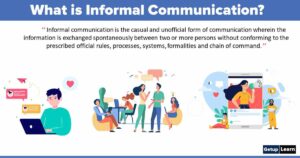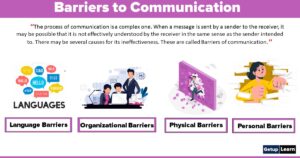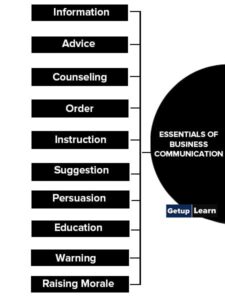Table of Contents
What is Horizontal Communication?
Horizontal communication is the communication where information flows among the similar or same level statuses of people in the organizational structure.
In other words, Communication that takes place at the same levels of hierarchy in an organization is called horizontal communication, i.e., communication between peers, between managers at the same levels or between any horizontally equivalent organizational member.
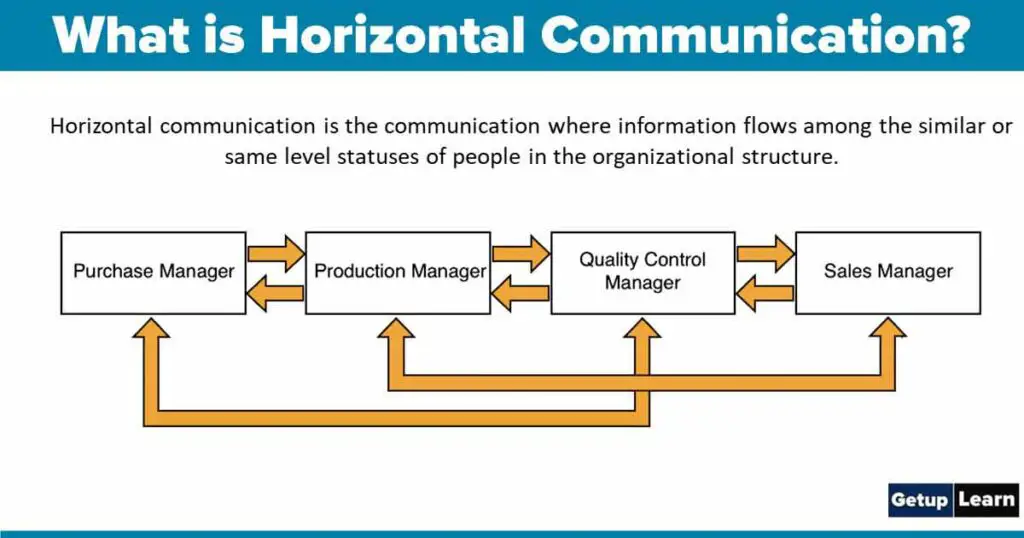
Table of Contents
Horizontal communication normally involves coordinating information and allows people with the same or similar rank in an organization to cooperate or collaborate.
Definitions of Horizontal Communication
Some definitions of horizontal communication are as follows:
Ricky W. Griffin, “Horizontal communication involves colleagues and peers at the same level of the organization.”
Bartol and Martin, “Horizontal communication are lateral or diagonal message exchange either within work – unit boundaries, involving peers who report to the same supervisor or across-work unit boundaries, involving individuals who report to different supervisors.”
According to William A. Conboy, “Horizontal communication is the exchanges between and among agencies and personnel on the same level of the organizational chart.”
According to Bovee and others, “Horizontal communication is the flow of information across departmental boundaries, either laterally or diagonally.”
According to Ivancevich and others, “Horizontal communication occurs when the communicator and the receiver are at the same level in the organization.”
So as you can see according to these definitions, Horizontal communication is the communication that flows laterally within the organization, involves persons at the same level of the organization
Methods of Horizontal Communication
Followings are the methods of horizontal communication:
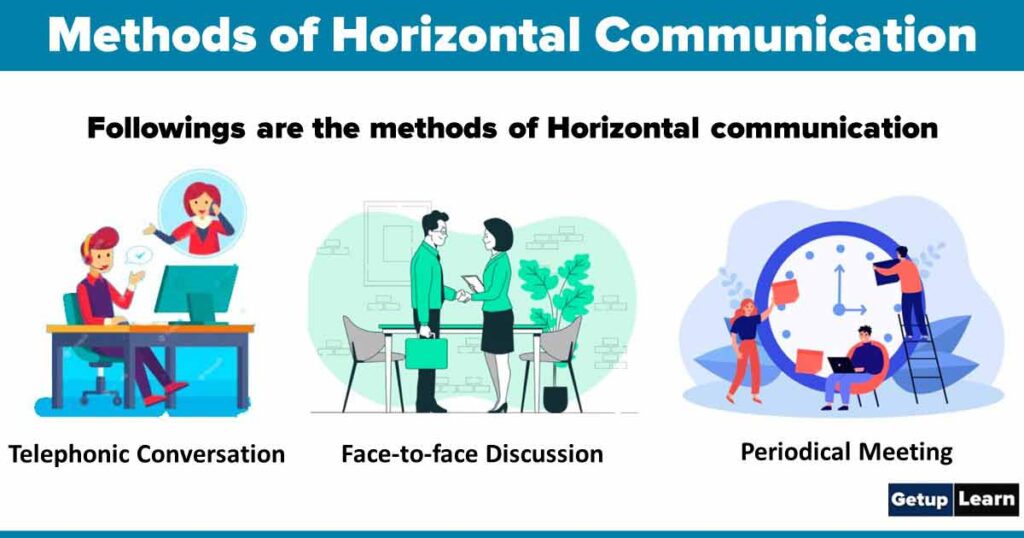
Face-to-face Discussion
When individuals communicate directly to another. Face-to-face communication minimises the problem of misinterpretation and quick feedback makes the communication more effectively.
Telephonic Conversation
When the employees are busy with their work or they are sited far from each other then the telephonic conversation becomes more relevant against the face to face conversation. It saves time but sometimes congestion or disturbance and any other obstacles create delay and distort the message.
Periodical Meeting
Periodical meeting means meeting between employees on a weekly, monthly, quarterly, annually basis where all the members are assembled and discuss pre-determined issues. Memorandum: Memorandum is a written form of communication that transmits between different departments in the same organisation. It is also called inter office letter.
Advantages of Horizontal Communication
Followings are the advantages of horizontal Communication:
- Informal and Sweet Relationship
- Co-ordination of Activities
- Departmental Communication
- End of Misunderstanding
- Hindering Bureaucracy
- Dynamism at Work
- Group Activities
- Guarding Against Distortion Message
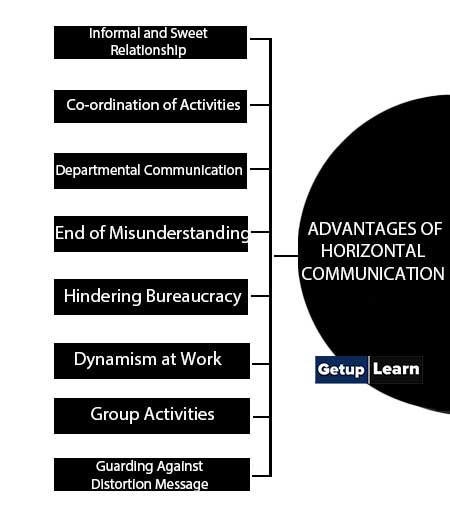
Informal and Sweet Relationship
This is the same status level’s communication system. They exchange ideas, knowledge and thoughts. So, an informal and sweet relationship can be maintained.
Co-ordination of Activities
For the achievements of the expected result of an organization inter-departmental coordination system must be developed which is a criterion of horizontal communication.
Departmental Communication
Horizontal communication is the best system of communication in departmental communication.
End of Misunderstanding
There is no chance of misunderstanding in horizontal communication among employees. So, it is helpful to management for enhancing mutual understanding and good decision making.
Hindering Bureaucracy
No chance of a rising bureaucracy in Horizontal communication running the organization which is helpful to make a good relationship among themselves.
Dynamism at Work
If horizontal communication is established in organizational dynamism at work will increase among workers.
Group Activities
In this system of communication, a department is well known to other departments and can exchange their affection. So, group activities and the direction of the sound work program will be easier.
Guarding Against Distortion Message
Horizontal communication takes place among the employees of the same level, information reaches directly from one employee or executive to another which acts as a guard against distortion messages.
Disadvantages of Horizontal Communication
Horizontal communication has not only some advantages but also some disadvantages which are followed:
- Lack of Motivation
- Over Specialization
- Overloaded by Information
- Wastage of Time
- Positional Problem
- Lack of Understanding
- Procedural Problem
- Damn-care
- Ignoring Vertical Communication
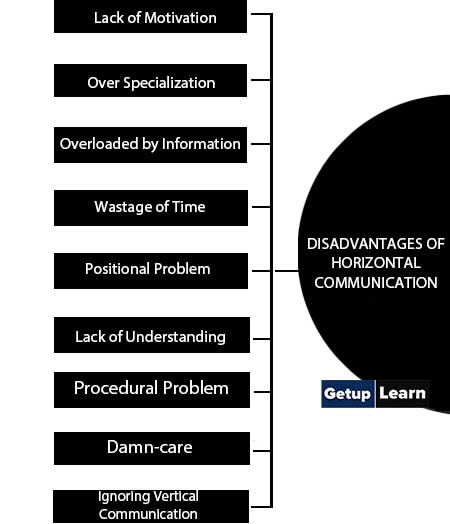
Lack of Motivation
Horizontal communication often fails simply because organization members are unwilling to expend the additional effort that it requires. It may require contact with people in units and the channels and rules of interaction may be unclear. Sometimes we do not really know these people. The need to communicate with them makes us uneasy or takes too much time.
Over Specialization
Specialization is a problem that often happens when organizations do not have uniformity within departments, causing communication difficulties. Specialization can occur with procedures or vocabulary used by different departments. When this occurs organizations have trouble functioning properly and do not run smoothly.
Overloaded by Information
Since information is less filtered in horizontal communication, one must sort through a greater amount of data which may lead to overload.
Wastage of Time
Such communication involves excessive sorting of data which can kill the useful and valuable time of superiors.
Positional Problem
For positional problems, horizontal communication must fail to fulfil the organization’s goal.
Lack of Understanding
For lack of understanding among employees, this communication may not be successful.
Procedural Problem
Sometimes horizontal communication is disrupted for procedural problems.
Damn-care
It takes place between equal ranking staff. So damn-care spirit is likely to be encouraged because of unclear channels and rules of interaction.
Ignoring Vertical Communication
In horizontal communication, the same level of organizational members are contacted or exchange information with each other. In most cases, they do not inform managers of the hierarchy which break down or ignore the vertical communication.
What are examples of horizontal communication?
Communication that takes place at the same levels of hierarchy in an organization is called horizontal communication, i.e., communication between peers, between managers at the same levels or between any horizontally equivalent organizational member.
What is horizontal or lateral communication?
Horizontal communication are lateral or diagonal message exchange either within work – unit boundaries, involving peers who report to the same supervisor or across-work unit boundaries, involving individuals who report to different supervisors.”
How many types of horizontal communication are there?
There are three types methods of horizontal communication: (1) Face-to-face Discussion, (2) Telephonic Conversation, (3) Periodical Meeting etc.
Read More Related Articles
[su_spoiler title=”What is Communication? | Mass Communication” style=”fancy” icon=”plus-circle”]
What is Communication?
[/su_spoiler]
[su_spoiler title=”Types of Communication | Principles of Communication” style=”fancy” icon=”plus-circle”]
-
Types of Communication
- Verbal Communication
- Non-Verbal Communication
- Written Communication
- Visual Communication
- Feedback Communication
- Mass Communication
- Group Communication
[/su_spoiler]
[su_spoiler title=”Nonverbal Communication | Verbal Communication” style=”fancy” icon=”plus-circle”]
[/su_spoiler]
[su_spoiler title=”Written Communication | Oral Communication” style=”fancy” icon=”plus-circle”]
Written Communication
[/su_spoiler]
[su_spoiler title=”Business Communication | Organizational Communication” style=”fancy” icon=”plus-circle”]
[/su_spoiler]
[su_spoiler title=”Formal Communication | Informal Communication” style=”fancy” icon=”plus-circle”]
[/su_spoiler]
[su_spoiler title=”Interpersonal Communication | Informal Communication” style=”fancy” icon=”plus-circle”]
[/su_spoiler]
[su_spoiler title=”Downward Communication | Upward Communication” style=”fancy” icon=”plus-circle”]
[/su_spoiler]
[su_spoiler title=”Barriers to Communication | Horizontal or Lateral Communication” style=”fancy” icon=”plus-circle”]
[/su_spoiler]



